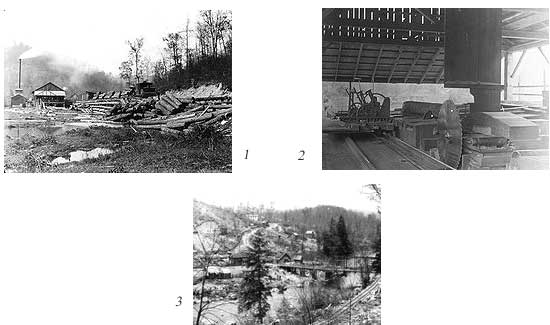
I am not sure, but I believe when these photographs were taken, the town had been renamed Kendall, a contemporary logging town with Crellin, also owned by the Kendall Brothers. Krug was the earlier name when the Albert Knabb and Henry Krug operated a wooden barrel-producing sawmill operation, shipping them to their oil wells in West Virginia and Pennsylvania and other destinations. The company owned specially modified flat cars for shipments of assembled barrels and boxcars for barrels in "kit" form. A perq of being a lumber capitalist was naming the town in one's honor, even if the name was Krug (or Crellin). One minor curiosity is that Knabb leased from the Yough Manor Land Company whose president was J. Henry Bayard. Jennings Brothers in the Casselman Valley bought their timberlands from Joseph Bayard of Harrisburg. Whether they two men were related or if they had any connection with Senator Bayard from whom Bayard WV was named is not known to this author. The A.Knabb & Co. operation commenced at Krug in 1892 and only bought certain species of timber (maybe white oak?) and moved on after it was cut in 1902. Kendall immediately moved in adding a band sawmill to Knabb's circular. One unique aspect of Knabb's railroad was the operation of a 16 ton Gilbert locomotive, perhaps the only one to operate in Garrett County. They followed with purchases of two new Climax Model B's. The Krug and Kendall logging railroads were extensive, going up the Yough to Swallow Falls, using most of the Deep Creek watershed and number other smaller streams. The lines connected with some other logging railroads, but probably no through traffic developed.
The first photo above shows logs being "snaked" or skidded down a steep hill. A full size view reveals the one gentleman in nice clothes for this work. The second photo shows a log being bucked to length. The bark has been peeled, perhaps this was a hemlock, indicating the Kendall operation. The third photo shows logs being loaded at a landing. Benjamin Kline states that A.Knabb handloaded while Kendall had a Barnhart loader.

<
From Tall Pines and Winding Rivers-Benj.Kline |
Preston Railroad |
Castleman River Railroad |
Garrett County Coal |
Operating Coal Loaders 2001 |